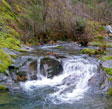| This article was published in the Independent Coast Observer on March 22, 2002, in a slightly different format. |
Courtesy Independent Coast Observer, Gualala, CA
The Gualala River Watershed Council decided Tuesday evening to draft a letter of concern to state and federal agencies about the Alaska Water Exports water bag proposal.
That required consensus, because the GRWC is a stakeholder group, not an advocacy group. The letter will be based on the vast amount of scientific knowledge of the watershed that GRWC and state agencies are compiling.
Facilitator Rose Hocker started the discussion by showing large recent newspaper articles about the proposals to extract water from the Gualala and Albion Rivers for shipment to Southern California. She mentioned the work of Ursula Jones with the re-activated Friends of the Gualala River.
The group then went over its mission statement, and saw that there is room for taking a stance based on watershed stewardship.
Then, using an overhead projector Hocker showed the recent water export opposition resolutions passed unanimously by the Mendocino and Sonoma County boards of supervisors.
She read an e-mail that Jim Jordan received from water entrepreneur Ric Davidge after his Saturday talk to the Sea Ranch Forum, saying that his engineer’s figures were all wrong, and that “changes are already under way based on your meeting.”
A stakeholder said, “Picking another river?”
Wayne Harris of Adventure Rents brought two more resolutions of opposition, one from the Redwood Coast Chamber of Commerce, and one from American Rivers which included a number of advocacy organizations.
The discussion came around to agreeing that a format similar to that of the county resolutions would be good, but with a much more scientific focus; expressing concerns that the agencies might not know about, rather than opposing the project.
“It looks like we have consensus on that,” said Hocker.
The GRWC is swamped with scientific data and charging out to get more. The North Coast Watershed Assessment Project draft report drew many local comments. Key issues were future public availability of data, better presentation of data, and disappointment that there seem to be few conclusions in the report.
Based on the maps in the NCWAP report, which presents the recent and collected past data by sub-watershed in a way not seen before, GRWC is revising its stream monitoring program.
A technical advisory committee met last Friday. Hydrologist Matt O’Connor advised the group that most of the current monitoring reaches are in areas of one to two percent stream gradient. He said more reaches are needed in two to eight percent gradient streams, the steepest that salmon and steelhead are likely to use.
O’Connor advised a total of 50 monitoring reaches in the 300-square-mile watershed. The TAC also is working on an informational packet for landowners, based on one used successfully in Oregon.
Another technical advisory committee will meet on Thursday, March 21, from 10:00 a.m. to 2:00 p.m. to hammer out a work plan for the estuary study funded by the State Coastal Conservancy. GRWC hopes to start work in the estuary May 1.
Nine candidates stepped forward for nine seats on the GRWC Steering Committee. If no-one else who is eligible comes forward soon, they will be seated. Steering Committee meetings take place in the afternoon on the day the watershed council meets in the evening, and are open to everyone.
 Friends of Gualala River Protecting the Gualala River watershed and the species living within it
Friends of Gualala River Protecting the Gualala River watershed and the species living within it
